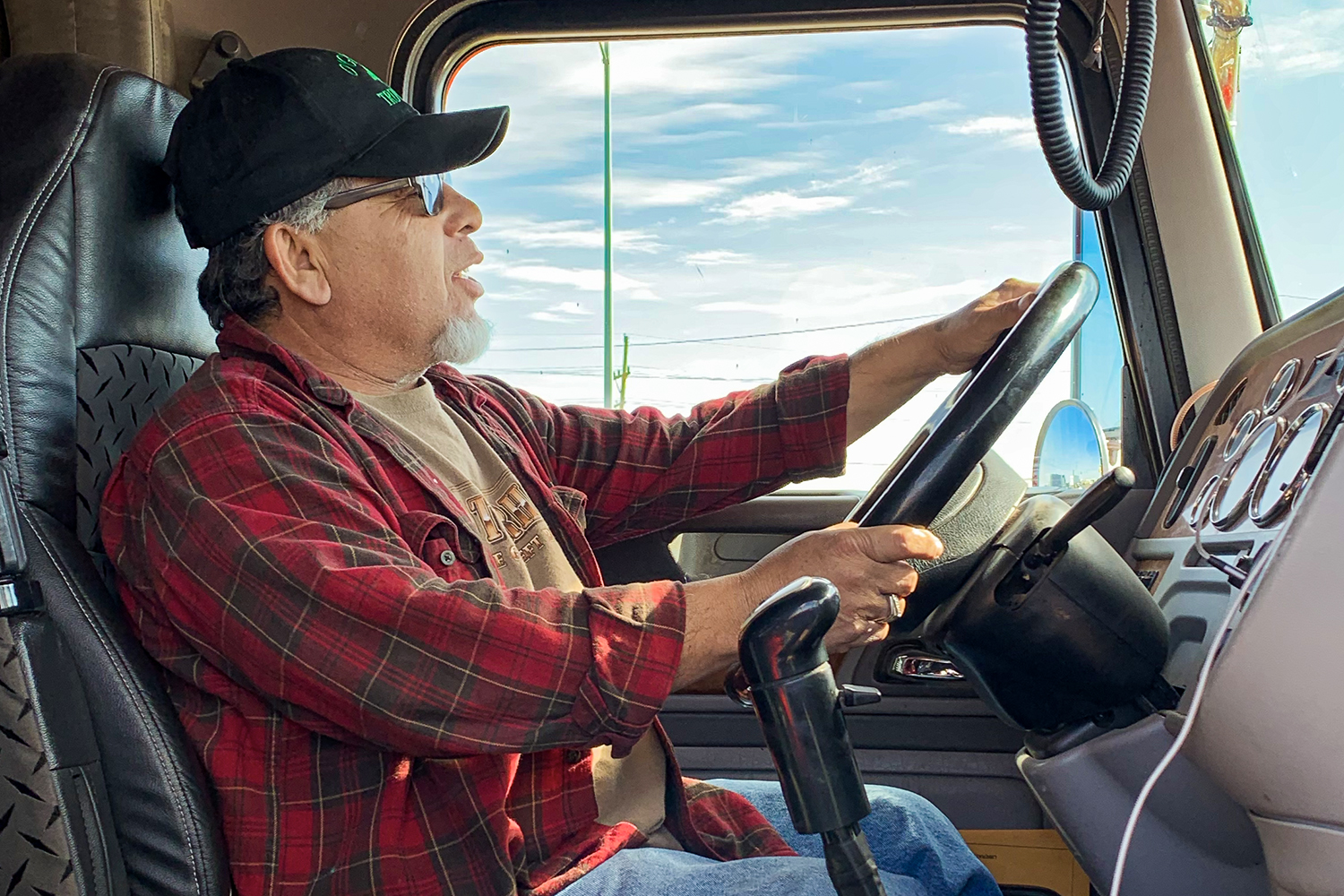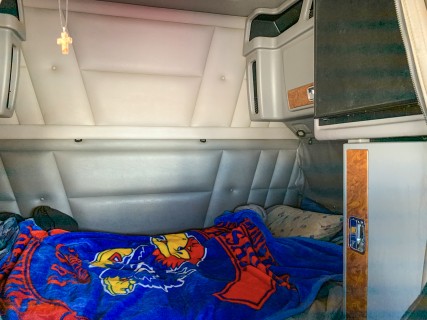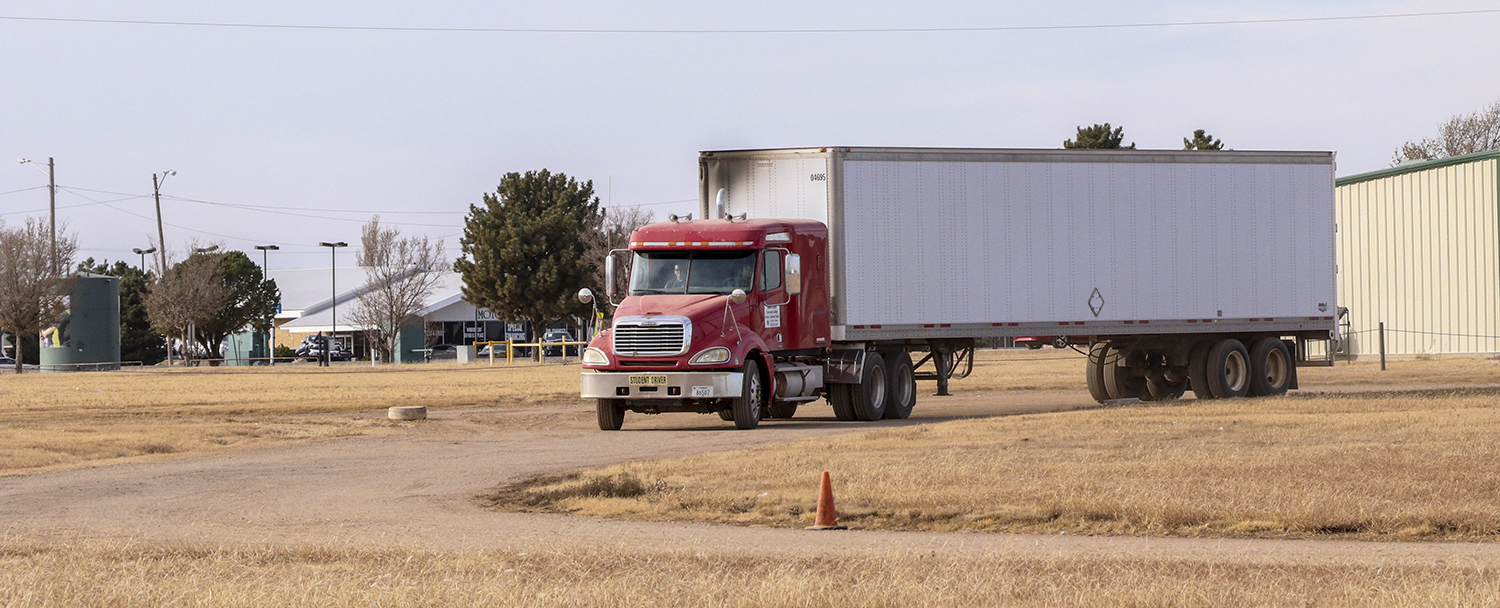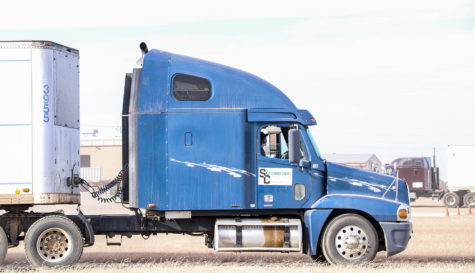
Annette Meza is a sophomore journalism major. She is 19 years old and was born and raised in Liberal. In her free time, she...


Experienced truckers share what it's like to be on the road
December 6, 2019
Freedom. It’s almost tangible when you’re driving 60 miles per hour in a 53-foot 18-wheeler down the interstate. You can feel it around you as the windows are rolled down with the music on blast, marching to the beat of your own drum. Or in this case, driving.
You might make a stop at noon for lunch or call your mom whenever you like. Or take a nap in the cab of the truck for five hours or more, only if you get your load done on time. You can invite whoever you want on the trip, whether a friend or significant other depending on the company you work for. You can be your own boss. This is what being a trucker is like for most semi-truck drivers.
However, you should also expect the unexpected. Flat tires, break-downs, delays and even being hit by another oncoming vehicle comes with the job. Phillip Jacobs, trucker for O’Grady Trucking, has almost 40 years of experience with this under his belt.
He sits in the driver’s seat of his semi. His cap lays atop his head and reads “O’Grady Trucking” in green, with a three-leaf clover in the middle. He wears a red flannel over an off-white graphic shirt and salt and pepper colored facial hair sits on his chin.
A cluttered mess of papers and miscellaneous objects sit at the bottom of the floor of the cab. In the back, a full-sized bed, a fridge, a TV and multiple cabinet compartments make up the living quarters of the semi. This is where Jacobs spends most of his time on the road, his home away from home.

Jacobs first began trucking in 1980. He was a driver for the U.S. Army before becoming a drill instructor. After driving for the U.S. Army, Jacobs went on to haul for Halliburton, an oil company. A week was all it took for the trucker to learn the basics, since back then, you were not required to be tested at an official credential driving school. He’s hauled cattle, worked for Nichol’s Water Service and was a hauler for an ethanol plant.
Jacobs says his favorite part about being a trucker is getting to see the many cities, towns and people he passes by. This seems to be a common reason among other truck drivers too, like for Chirma Burger, who is from Hugoton and is a Seward County Community College commercial drivers license/truck driving student.
Burger agrees that the best part of the job is the sight-seeing and meeting new people, plus seeing interesting things happen on the road. But trucking is not just about the traveling and the freedom. It’s long hours on the road, feeling fatigued, hours without sleep, maybe even without food and water. It’s not being able to see your family for long periods of time. It’s unexpected delays and accidents. Driving a truck is a skill that requires a lot of attention to the things around you and perseverance.
Anyone can be a truck driver, but not everyone can have what it takes. Manuel Hernandez, SCCC CDL and truck driving instructor from Liberal, says that this is a job you must genuinely like to do it full time.
“If you don’t like your job, you won’t be able to handle all that comes with it. It can be tough being away, especially when a family member gets sick because you won’t be able to turn around and stop to come back,” Hernandez says.
“Being a truck driver is not easy. It’s a job that takes away from your personal life too. You leave home and you never know when you’re coming back. You have to work hard.”
Jacobs adds that one needs discipline and dedication, too. Sacrifices such as losing sleep, personal time to rest at home, not seeing family and other basic needs become second priorities.
In Hernandez’s experience, he was away from his family a lot and would go multiple days without coming home. When he did finally come home, he says he did not get much time to relax on his own, since his family was always wanting to go out, “but ultimately it was okay as long as I got to spend time with them.”

Hernandez was a truck driver before becoming an instructor at SCCC. He hauled loads for oil field companies and says he somehow ended up becoming an instructor at Seward. In his class, the students begin learning from the handbook. Once they complete the book, Hernandez sends his students to take the test at the Department of Motor Vehicles for their permits. Once they pass, he takes them to finally learn how to drive.
To sign up for the class, contact the SCCC admissions office. The class lasts for six-weeks.
“Being in this class, you have to have common sense. If you don’t have common sense, then you basically can’t do this job. You have to listen, pay attention and be in class, because when they say something, it’s for safety reasons,” Burger says.
Trucks can be scary vehicles on the highway. Though they look and feel like they are traveling fast as they zoom right beside you, they are only able to only drive up to only 60 miles per hour, at most 65. Because of this, the weight that is added and being hauled can make the truck difficult to stop. It takes the distance of almost two football fields to get a truck to break to a full stop.
“When you stop a truck, there’s no way you can stop as quick as a car. We train our students to know this, so they could be aware of what’s in front and around them while driving, which is where common sense takes place,” Hernandez says.

The back roads behind the industrial school are used as a course for the CDL students to drive on. The students are able to drive around in a circle until they have the hang of things.
During the driving portion of the training, Martinez says that they begin by moving the trucks forwards and backwards. Once they learn the gears and how to turn, they take them on the back roads, which is currently where they are at during the course. After the back roads, they’re finally able to learn the routes that trucks take in town.
“It’s truly a powerful feeling to drive a truck. The fact that it’s not just driving a car, but a 129,000 pound vehicle feels empowering once you learn how to drive and how to keep yourself and others safe,” Burger says.
Learning how to keep others safe is a big part of the class. Colliding with oncoming vehicles is the last thing a driver would want to happen, but a lot of the time, it can’t be helped. Hernandez always advises students to steer the truck to the right if something happens, since the vehicle cannot stop in less than 10 seconds. According to McAleer Law, around 500,000 trucking accidents occur each year in the United States, with about 5,000 per year resulting in death.
The last thing Jacobs remembers before ending up in Wichita’s Wesley Medical Center was turning off cruise control and down shifting. On June 5, 2012, Jacobs drove down highway 50 just two miles outside of Coolidge. He lost control of the large semi as he choked on a mint. His truck hit the guard rail, and flipped over to the side of the road, which then left the vehicle in three pieces.
“When this was happening, I seriously thought ‘this is it, I’m going to die’ It’s a weird feeling,” Jacobs says.
Jacobs suffered from injuries such as a severe concussion, 40% vision loss in his right eye, as well as needing surgery on his thumb and pointer finger. He also says he has short term memory loss that results from the concussion.
“Sometimes I’m talking to someone, but I’ll forget what I’m saying. I’ve learned to live with it,” Jacobs says. “They told me I would never be able to drive again, but I’ve proved them wrong.”
Despite the struggles that came after the accident, Jacobs persevered and was able to get behind the wheel again. He says that most people would give up, but not him, “to me, you continue on.”
Burger experienced the same kind of miracle accident, two weeks before beginning her CDL classes at SCCC. She and her husband were driving in South Carolina, east bound on the interstate. Her husband began to cough, which she thought was a heart attack, but she was wrong.
Burger’s husband blacked out and hit the steering wheel. Immediately, she attempted to grab the wheel, only worrying for the safety and health of her husband. It was too late. With his weight on the wheel, her husband pulled the truck to the left of the interstate, drove past steel cables and the truck ended up west bound.

Seward County Community College offers CDL license classes on campus which lasts for six weeks. At the moment, the class has began to practice on the back roads, where they are taught the gears first and how to drive slowly before they are taken on the route in town.
A 40-foot drop to the ground came shortly after, propelling Burger forward as her husband stayed in place, still blacked out. Adrenaline rushed through her, and she recalls only her leg burning but feeling no pain otherwise.
“There was definitely a higher power watching over us that day. We drove past mountains, and it didn’t happen there, we drove over a bridge and it didn’t happen there. The fact that God wanted it to happen over there is totally okay with me,” Burger says.
Burger suffered a cut lip and three knocked out teeth. Like Jacobs, this accident did not frighten or discourage her, but only made her stronger. Burger now decides that she wants to leave her job at law enforcement and become a trucker after contemplating it for some time.
“I’m not afraid to pursue a career in CDL because I know and recognize the dangers that come with the profession. If anything, surviving that crash really showed me that this is what I’m supposed to do and God has a bigger plan for me and my family,” Burger says.
Once Burger finishes the CDL program at Seward, she expects to find a new sense of freedom that her 9-5 office job could never give her, driving with the music up, windows down and being her own boss.

Annette Meza is a sophomore journalism major. She is 19 years old and was born and raised in Liberal. In her free time, she...